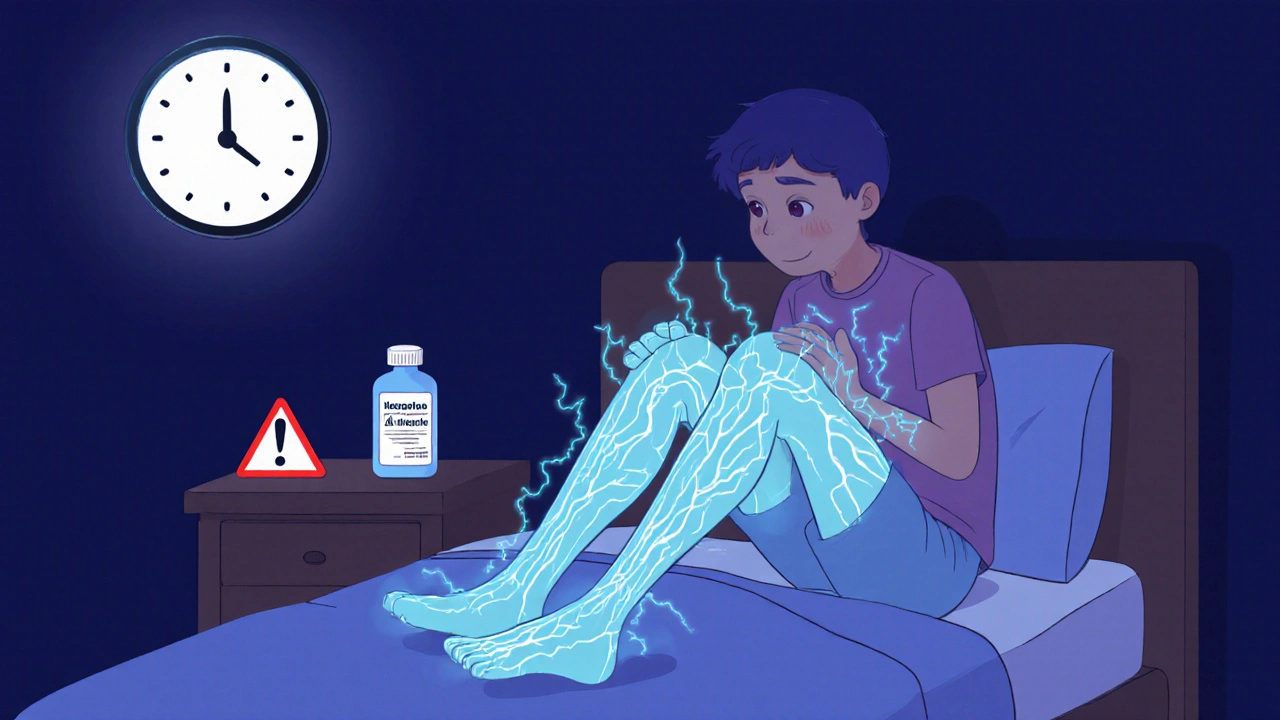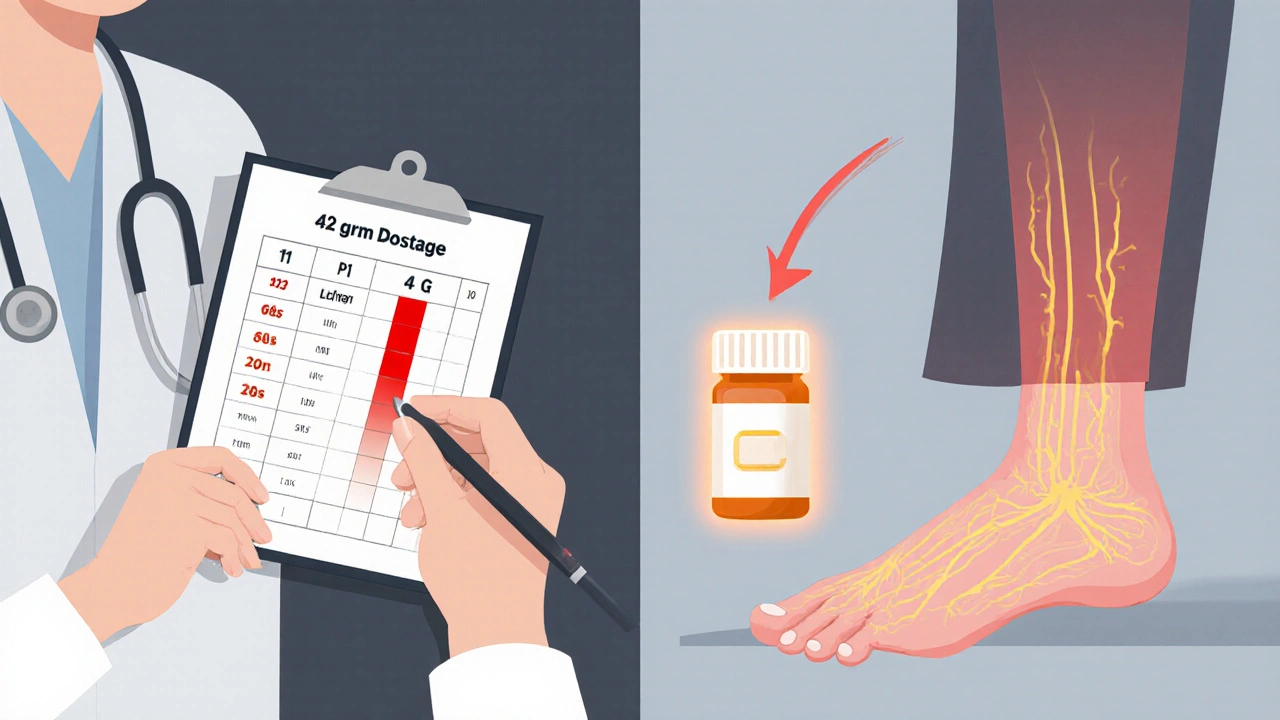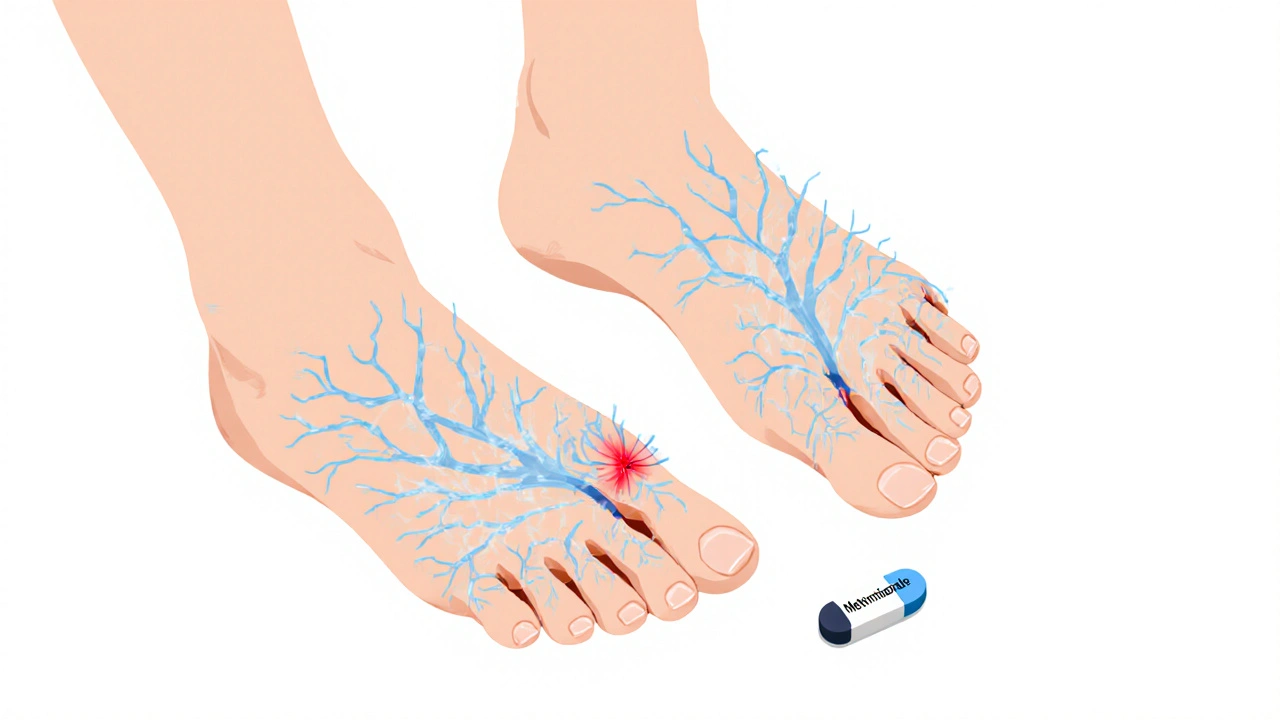Metronidazole Neuropathy Risk Calculator
Determine Your Metronidazole Risk
This calculator helps you understand how your metronidazole dosage relates to the 42-gram threshold where neuropathy risk increases significantly.
Important: If your total dose exceeds 42 grams, or if you experience numbness, tingling, or burning sensations, consult your doctor immediately and stop taking metronidazole.
When you take metronidazole for a stubborn infection-whether it’s bacterial vaginosis, a C. diff flare-up, or a liver abscess-you expect relief, not new problems. But for some people, the very drug meant to kill bacteria starts attacking nerves instead. The signs are subtle at first: a quiet tingling in the toes, a strange numbness creeping up the feet, or a burning sensation that gets worse at night. These aren’t just side effects. They’re early warnings of metronidazole neuropathy, a serious and often missed neurological injury tied directly to how much and how long you’ve taken the drug.
What Metronidazole Neuropathy Actually Feels Like
Metronidazole-induced peripheral neuropathy doesn’t show up as swelling or redness. It creeps in silently, like frost spreading across glass. The most common symptoms are numbness, tingling, and sharp, electric-like pain-usually starting in the feet and hands. It follows a ‘stocking-glove’ pattern: first the toes, then the soles, then the ankles, and eventually up the legs. Same thing in the hands-fingers go numb, then the palms, then the wrists. Many patients describe it as walking on pebbles or wearing invisible gloves that won’t come off.
It’s not just sensation. Some people lose balance because their feet can’t feel the ground. Others can’t button shirts or hold a pen. Nighttime pain is a hallmark-sleep becomes impossible. One 69-year-old woman, treated for diverticulitis with 55 grams of metronidazole, said the burning in her feet was so bad she had to soak them in cold water just to get a few hours of rest. Another man, a carpenter on 168 grams for a liver abscess, couldn’t grip his tools anymore. The pain wasn’t just physical-it cost him his job.
The 42-Gram Threshold: When Safe Becomes Dangerous
Metronidazole is usually safe for short courses-five to seven days for most infections. But when treatment stretches beyond that, the risk spikes. The critical turning point? 42 grams total. That’s 500 mg three times a day for about four weeks. Below that, less than 2% of people develop nerve damage. Above it? Nearly 18% do. That’s a 10-fold jump in risk.
Even more alarming: some cases have appeared after just 10 days of high-dose therapy. One 15-year-old girl developed severe nerve pain and temperature dysregulation after a 14-day course for a rare infection. Her feet felt freezing, even in warm rooms. She had to submerge them in ice water to ease the pain. This wasn’t just neuropathy-it was autonomic nerve damage, something rarely seen before with this drug.
The problem isn’t just duration-it’s cumulative exposure. Each pill adds up. A standard 7-day course is 10.5 grams. A 14-day course? 21 grams. A 28-day course? 42 grams. That’s the red line. And many doctors don’t track it. A 2023 survey found only 38% of primary care physicians knew this number. Most assume if the infection isn’t gone, they just keep prescribing. But that’s when the damage begins.
Why Does This Happen? The Science Behind the Nerve Damage
Metronidazole doesn’t just target bacteria. It slips easily into nerve cells because it’s small and fat-soluble. Once inside, its chemical structure-specifically the nitro group-gets broken down by the cell’s own enzymes. This creates reactive molecules that attack mitochondria, the energy factories of nerves. The result? Swelling, dysfunction, and eventually, nerve death. This isn’t inflammation-it’s direct chemical toxicity.
Animal studies show this process clearly. Nerve fibers swell, the myelin sheath (the insulation around nerves) breaks down, and signals slow or stop. That’s why nerve conduction tests show reduced sensory and motor responses. It’s an axonal neuropathy-meaning the long fibers of the nerve are dying, not just the outer layer. That’s why recovery takes months, even after stopping the drug.
Unlike diabetic neuropathy, which progresses slowly over years, metronidazole damage can go from mild tingling to walking difficulty in weeks. And unlike chemo-induced neuropathy, which often leaves permanent scars, most cases (94%) improve after stopping the drug. But 6% don’t. And those patients are left with chronic pain, muscle weakness, and disability.

Differentiating It From Other Neuropathies
Doctors often mistake metronidazole neuropathy for something else-especially if the patient has diabetes. Both cause numb feet. But there are key differences.
- Diabetic neuropathy: Usually starts in the feet but progresses slowly. Often accompanied by foot ulcers, slow-healing wounds, and loss of reflexes. Pain is more aching than electric.
- Vitamin B12 deficiency: Causes numbness too, but usually with tongue soreness, fatigue, and memory issues. Blood tests show low B12 levels.
- Chemotherapy neuropathy: Often asymmetrical, affects hands and feet unevenly, and rarely improves after stopping treatment.
- Metronidazole neuropathy: Symmetrical, sensory-predominant, worsens at night, and has a clear link to recent antibiotic use. Often includes autonomic symptoms like temperature sensitivity or sweating changes.
Also, metronidazole doesn’t cause muscle weakness early on-unless it’s advanced. If you’re weak in your legs and numb in your feet, that’s a red flag. And if you’ve been on metronidazole for more than four weeks, the cause is likely the drug, not something else.
What to Do If You Suspect It
If you’re on metronidazole and notice any numbness, tingling, or burning-especially in your feet or hands-stop taking it immediately. Don’t wait for a doctor’s appointment. Don’t assume it’s ‘just a side effect.’ Call your prescriber today. The sooner you stop, the better your chance of full recovery.
Don’t rely on blood tests or imaging. Nerve damage from metronidazole doesn’t show up on MRIs or routine labs. The best diagnostic tool is a detailed history and a simple question: “Have you noticed any unusual sensations in your hands or feet since starting this medication?” The Total Neuropathy Score, a validated questionnaire used in clinics, picks up early changes in 89% of cases.
Electromyography (EMG) can confirm it, but waiting for results risks permanent damage. If clinical suspicion is high, stop the drug. No test is worth losing your ability to walk or grip things.

Recovery: How Long Does It Take?
Recovery isn’t instant. Some people feel better in two weeks. Others take six months. One case study followed a teenager who took metronidazole for 14 days and developed severe neuropathy. Even after stopping, it took six months of physical therapy before her nerve tests returned to normal.
Physical rehab makes a huge difference. Patients who did structured exercises-balance training, foot strengthening, sensory retraining-regained normal walking speed 37% faster than those who didn’t. Pain management helps too. Gabapentin, pregabalin, or duloxetine can ease the burning, but they don’t fix the nerve damage. Only stopping the drug does that.
And yes, you can get better. Most people do. But the window is narrow. Delaying discontinuation by even a few weeks can mean the difference between full recovery and lifelong pain.
How to Prevent It
Prevention is simple: don’t take metronidazole longer than needed. The Infectious Diseases Society of America now recommends against any course exceeding 42 grams unless there’s clear proof it’s still working. Hospitals like Mayo Clinic have built hard stops into their electronic systems-after 28 days, the prescription blocks unless an infectious disease specialist approves it.
Ask your doctor: “How many grams total am I getting?” and “Is there a safer alternative?” For many infections-like bacterial vaginosis or giardiasis-shorter courses or different antibiotics (like tinidazole) are just as effective and carry less nerve risk.
There’s also new hope. A clinical trial at UC San Francisco is testing whether adding alpha-lipoic acid (600 mg daily) protects nerves during long-term metronidazole use. Early results look promising. But until that’s proven, the safest approach is still: use the lowest dose for the shortest time possible.
The Bigger Picture
Metronidazole is cheap, widely available, and effective. That’s why over 10 million prescriptions are filled in the U.S. every year. But as antimicrobial stewardship pushes doctors toward narrow-spectrum drugs, more people are getting exposed to this hidden risk. The cost isn’t just medical-it’s personal. One case of permanent neuropathy adds $247,000 in lifetime healthcare costs for pain management, therapy, and lost income.
The FDA updated its warning label in 2023 to highlight the 42-gram threshold. But warnings mean nothing if doctors don’t know them. The solution isn’t more warnings-it’s better education, better tracking, and better communication between patients and providers.
If you’re on metronidazole for more than two weeks, ask for a neurological check-up. If you’re prescribed it for more than four weeks, demand a second opinion. Your nerves can’t wait for a diagnosis. They need action-now.

9 Comments
Write a comment